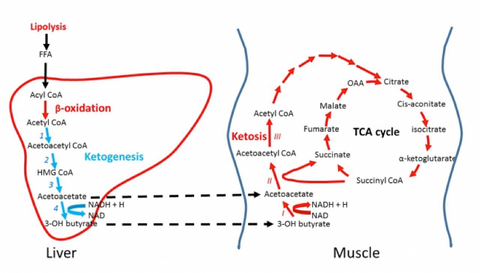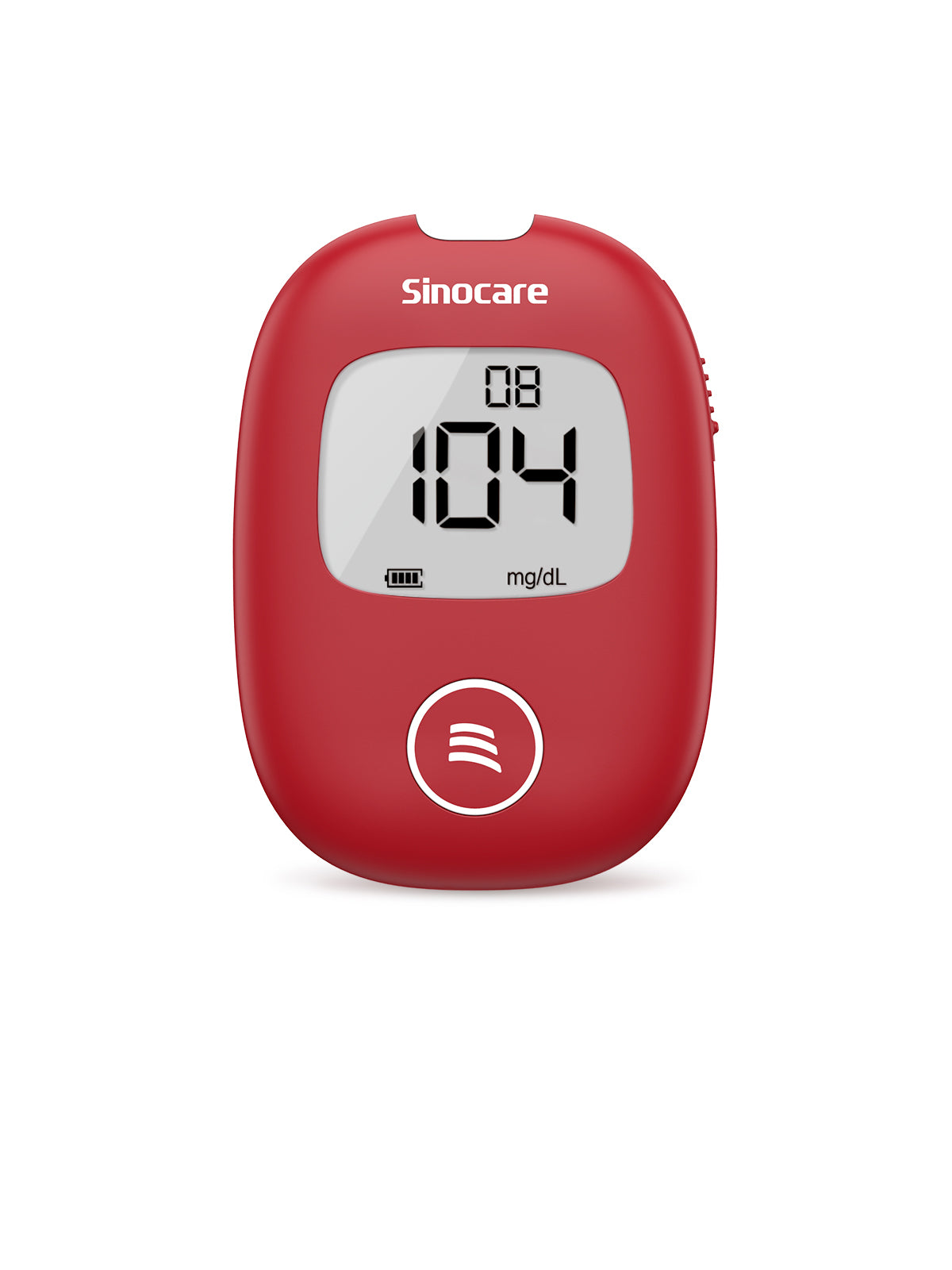Many people have heard of the ketogenic diet, which is a very popular diet recently. The ketogenic diet and blood sugar test are inextricably linked, and it is important to maintain the optimal blood sugar level for ketosis. If your blood sugar levels often rise, your body will not be able to maintain a ketogenic state, which is the main goal of ketogenic dieters.
We will look at what keto is, the two types of ketosis, how to calculate your optimal blood sugar keto level and the applicability of the ketogenic diet to diabetics.
The Concept of Keto
When insulin treatment is interrupted or the dose is insufficient for insulin-dependent diabetic patients, and non-insulin-dependent diabetic patients suffer from various stresses, diabetic metabolic disorders increase, lipolysis accelerates, and the production of ketone bodies increases beyond utilization and accumulates. When ketone bodies accumulate in the blood, Called ketonemia, and its clinical manifestations are called ketosis. The reference range of the normal value of blood ketone is 0.03 mmol/L to 0.5 mmol/L.
Two Types of Keto
Diabetische Ketoazidose

Diabetic ketoacidosis (DKA) is an acute complication of diabetes. It is acidosis triggered by a severe shortage of insulin caused by a sharp rise in blood sugar. It is characterized by acidosis, severe dehydration, disorder of electrolyte balance, impaired oxygen system, peripheral circulatory failure and renal dysfunction, and central nervous system dysfunction. Diabetic ketoacidosis is an acute complication of diabetes that can be prevented. Once ketoacidosis is found, in addition to increased blood sugar and strong positive urine ketone bodies, the blood pH value drops and the blood carbon dioxide binding capacity is less than 13.5 mmol/L. If the condition is severe, coma can occur, which is called diabetic ketoacidosis coma. Drink plenty of water and go to the hospital for treatment immediately. Diabetic ketoacidosis is a serious complication of diabetes and the main cause of death from diabetes before insulin is used. After the advent of insulin, its fatality rate has been greatly reduced, and currently only accounts for 1% of the fatality rate of diabetic patients.
Clinical manifestations of diabetic ketoacidosis:
1. Diabetes symptoms worsen. Polydipsia, increased urine output, fatigue, etc., but no obvious overeating.
2. Digestive system symptoms. Loss of appetite, nausea, vomiting, vomiting can also occur after drinking water.
3. Respiratory system symptoms. In acidosis, the breathing is deep and fast, which is Kussmonl breathing. When the arterial blood PH value is lower than 7.0, breathing becomes shallower and slower due to paralysis of the respiratory center and muscle weakness. There may be an acetone smell (rotten apple smell) in the exhaled breath.
Fourth, dehydration. When the amount of dehydration exceeds 5% of body weight, the urine output decreases, the skin and mucous membranes are dry, and the eyeballs are sunken. If the amount of dehydration reaches more than 15% of body weight, due to decreased blood volume, circulatory failure, rapid heart rate, drop in blood pressure, cold limbs, and no significant increase in body temperature even if combined with infection.
5. There are obvious individual differences in mental state, dizziness, headache, and listlessness in the early stage. Gradually, drowsiness, irritability, dullness, loss of tendon reflexes, and coma often appear pathological reflexes.
Six, other symptoms. Extensive severe abdominal pain, tight abdominal muscles, and occasional rebound pain are often misdiagnosed as acute abdomen. Refractive errors may occur due to dehydration.
Starvation keto

The daily intake of protein, carbohydrates, and fats in diabetic patients needs to be controlled. The purpose is to control the intake of sugar from the diet, thereby controlling blood sugar.
Therefore, many people with diabetes believe that eating less can control blood sugar more effectively, but they ignore a very important problem: they are hungry for a long time, and hungry ketosis is very likely to occur. The starvation state tends to gradually reduce the glycogen in the liver and cause exhaustion. On the one hand, there is a lack of food carbohydrate supplementation, and on the other hand, the glucose stored in the liver is exhausted. The energy required by the body depends on the fat stored in the body. However, when fat catabolism is enhanced, it is often accompanied by incomplete oxidation, and it is easy to produce too many intermediate products, such as acetone and acetoacetate B-hydroxybutyric acid, which are collectively referred to as ketone bodies. Under normal circumstances, ketone bodies in the blood are minimal. If ketone bodies in the blood are too high due to long-term hunger, and ketone bodies in the urine appear, starvation ketosis will occur.
People with mild starvation ketosis only have increased blood ketone bodies, and ketone bodies appear in urine, and there is no clinically obvious symptoms. In moderate to severe patients, metabolic acidosis occurs due to excessive accumulation of ketone bodies in the blood, and symptoms such as weakness, fatigue, thirst, excessive urination, loss of appetite, and aggravated nausea and vomiting occur in the early stage. As the disease progresses, the patient develops headaches, takes a deep breath, smells like rotten apples, and gradually falls into lethargy, confusion, and coma.
Compared with diabetic ketoacidosis, although both are ketosis, starvation ketosis is characterized by normal or low blood sugar and ketosis, but the acidosis is not serious. One hour after a meal, the ketone bodies in the urine basically disappeared. Starvation ketosis and diabetic ketoacidosis have many similarities in the clinical manifestations of moderate to severe patients. Therefore, if a diabetic person develops ketosis, it is necessary to distinguish which ketosis is before treatment.
Ketogenic diet and Keto Blood Sugar Levels
The ketogenic diet isabout eating high-fat, low-carbohydrate foods to achieve ketosis. Most people who start dieting are looking for weight loss, reversing insulin resistance, and other metabolic syndromes.
According to Thehappytypeone, Julia has gived us a wonderful keto list of low-carb alternatives for pizza, pasta and more. For example, we should have Keto pizza, instead of ready prepared pizza.
Carbohydrate metabolism is broken down into glucose, which has the effect of directly raising blood sugar. Diabetic patients need to control carbohydrate intake to avoid a significant increase in blood sugar. The amount of carbohydrates in a low-carbohydrate diet (LCD) is less than 40% of the total energy. Reducing carbohydrate intake can reduce glucose metabolism and increase fat and protein consumption accordingly. Low carbohydrates can avoid a significant increase in blood sugar, while reducing blood sugar fluctuations, and also help reduce the body's insulin levels. Reducing the intake of carbohydrates can also affect the basic metabolism of sugar by regulating the decomposition rate of liver glycogen, thereby reducing blood sugar indicators. The American Diabetes Association (ADA) also recommends a low-carbohydrate diet as part of diabetes treatment.

Epidemiological studies have shown that low-carbohydrate diet can improve cardiovascular risk factors, especially plasma lipids such as triacylglycerol, total cholesterol, low-density lipoprotein cholesterol and high-density lipoprotein cholesterol.
Keto is a temporary state in which your body converts the energy source from glucose to fat in the form of ketones. This happens when the body reaches a low level of glucose. The ketogenic diet attempts to induce this state by restricting the intake of carbohydrates for a long time, so that the glucose in the human body will be reduced, which in turn forces the body to switch its fuel source to supply energy with fat. If you want to maintain a balanced blood sugar level, a ketogenic diet can help. Reduce glucose intake by reducing carbohydrate intake.
Your blood sugar levels won't tell you if you're in keto, but keeping them steady is important to keep keto at bay, and measuring your blood sugar levels can also help you manage keto. So you need to keep your blood sugar at normal levels. According to the American Diabetes Association, normal blood glucose levels are:
- Fasting blood sugar: 100 mg/dL and below
- One hour after a meal: 90-130 mg/dL
- Two hours after a meal: 90-110 mg/dL
- Five hours or more after a meal: 70-90 mg/dL
- Glycated hemoglobin: 5.7% and below
Use our Sinocare blood glucose meter to test you blood sugar more accurately.
The Optimal Blood Glucose Level For Keto.
How to know the quality of blood ketone GKI?
Urine ketone test paper can only detect the ketone bodies excreted by the body, but it is impossible to know whether the body has entered nutritional ketogenesis. Whether the body burns the fat that is eaten or the body's own fat. In fact, many people who enter a stable keto state later Even ketone bodies cannot be detected because the body has burned and digested the ketone bodies on its own.
So how to measure the concentration of ketone bodies during ketogenesis can best understand the fat-burning situation? At present, the most reliable basis is the Glucose ketone Index, which is also known as GKI. It was developed by Professor Thomas of Boston University and Developed together with his colleagues. It calculates the ratio of blood sugar to blood sugar to determine whether your current body state is in the optimal fat-burning zone.
First, use a blood glucose meter to measure your blood glucose level, and then divide this number by your blood ketone level (unit is mmol). The last number is your GKI today.

Studies have shown that the GKI value range with the highest fat-burning efficiency is 0.7-2. For example, the blood sugar I measured today is 5.3 and the blood ketone is 1. This index is 5.3 divided by 1, which is 5.3 medium ketone status, and the distance to the perfect index needs more work!
When to choose a ketogenic diet?
The ketogenic diet is not suitable for all diabetic patients, it also has a certain range of applications. It is suitable for type 2 diabetic patients aged 18 to 65 years old, overweight or obese ( BMI>24kg/m2), with body fat percentage higher than the normal standard for the same age, normal liver and kidney function, and without serious chronic complications of diabetes.
Common adverse effects of the ketogenic diet

The ketogenic diet replaces the previous dietary pattern, it has some potential adverse reactions, but the adverse reactions are mostly temporary (can disappear naturally when the body adapts to the function of ketone bodies instead of glucose as fuel).
① Hypoglycemic reaction: It usually occurs after 4-7 days of ketogenic diet, some fat loss will show hypoglycemia such as weakness, palpitations, panic, sweating and hunger, but it will disappear naturally after a week.
②Hunger: It is normal for the body to feel hungry during the process of converting from carbohydrate energy supply to ketone body energy supply, and it is usually a week or several weeks to gradually adapt.
③Flushing and heart rate acceleration: flushing and heart rate acceleration in the first week of ketogenic diet may be caused by hypoglycemia and ketone bodies or mild acidosis, which requires timely monitoring of blood sugar level and symptomatic treatment of hypoglycemia, while the other two phenomena can be corrected by drinking more water.
④Itchy skin and rash: a few sensitive people feel allergic to the ketone bodies produced by the body, producing itchy rash and other phenomena, at this time, you can take a bath twice a day and add a weak alkaline body wash, the symptoms can be relieved after 1-2 weeks.
Is ketogenic diet beneficial to diabetes?
Experts explain that if people do not grasp the degree of the ketogenic diet in the process of treating diabetes, they will be afraid of getting sick, so doctors in China do not recommend diabetics to use this diet for treatment, and their advice is to eat a balanced diet.
The ketogenic diet may also bring great risks to diabetic patients, the most serious of which is to cause diabetic ketoacidosis, so I hope that all diabetic patients do not easily try it themselves if they really want to try it, but also must be under the guidance of a doctor. If a patient eats only vegetables without food every day, there is a high risk of hypoglycemia, which is more harmful than hyperglycemia.
Sinocare hopes that the majority of diabetics will carry out their treatment in a reasonable and regular manner, and not follow the trend blindly.










1 comment
Manfred Hölzemann
Ich habe BMI 32,9 möchte mein bauchfett-gewicht reduzieren ketostix 40 Blutzuckermessgerät auf mmol/l umgestellt zeigt 4,6 mmol/l an. Habe Parkinson nehme einige Medikamente deswegen ein . Bin ich in einer Ketose?
Leave a comment
All comments are moderated before being published.
This site is protected by hCaptcha and the hCaptcha Privacy Policy and Terms of Service apply.